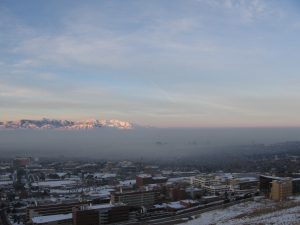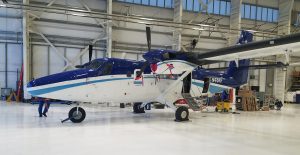Salt Lake City, Utah has the reputation of being a pristine mountain city, so it may surprise non-residents to learn that the region has some of the worst wintertime air pollution events in the country. The densely populated region is surrounded on three sides by mountains and experiences cold, snowy winters, leading to frequent temperature inversions which trap pollutants near the ground (more on this in a future post!). During these multi-day inversion events, levels of particulate matter often rise far above the National Ambient Air Quality Standards. However, it isn’t clear exactly why this happens — the chemistry is complex, and many meteorological factors are at work.

An inversion event in Salt Lake City. Photo credit: unews.utah.edu
The goal of the Utah Winter Fine Particulate Study (UWFPS) is to reach a more complete understanding of this complicated chemistry, so that the city can take steps to mitigate the factors that lead to pollution events. By pinpointing emission sources and instituting regulations, the particulate levels can be decreased.
We are a team of scientists from CIRES and NOAA’s Earth System Research Laboratory, working with collaborators from the Universities of Washington, Toronto, and Utah, the US EPA, and the Utah Department of Air Quality (UDAQ). Over the next several weeks, we will take nearly 80 hours of air quality measurements aboard the NOAA Twin Otter aircraft (pictured below), on repeated flights through three valleys in the Great Salt Lake region. Our instruments will measure the size and chemical composition of particulate matter, and many gas-phase chemical species involved in the formation of particulate matter, including ozone, reactive nitrogen species, and ammonia. Simultaneous measurements at the University of Utah, Brigham Young University and Utah State University will provide around-the-clock observations of these species from the ground. Through these observations, we hope to achieve a clearer picture of the chemistry that occurs during a typical inversion event and share this information with state officials to help improve air quality in Salt Lake City.

The NOAA Twin Otter at the NCAR Research Aviation Facility
This campaign has been in the planning stages for over a year, so we are excited to finally get started! Stay tuned as we bring you updates, and otter-related puns, from the field…
